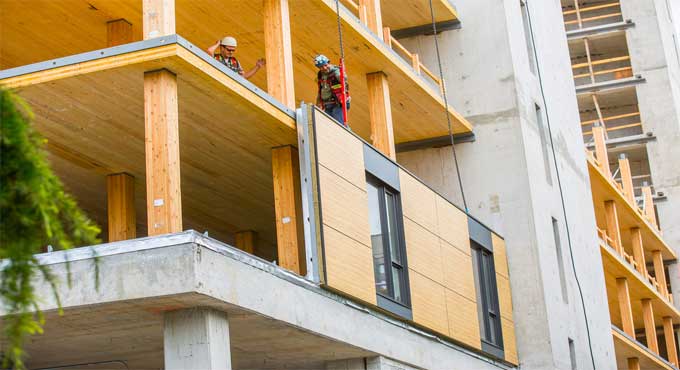
The Benefits of Cross Laminated Timber (CLT) during Construction

Cross Laminated Timber or CLT is produced in large panels, usually with a thickness of 3 to 10 inches, and can be used in a variety of applications ranging from floors, walls and roofs.
The panels are usually made from softwood species like spruce, fir or pine and can be used in combination with conventional building materials like steel and concrete. The solution for cross laminating timber is to stack and glue layers of kiln dried lumber perpendicularly.
CLT is an engineered wood product. Among the many characteristics that distinguish CLT, it stands out for its strength, appearance, versatility, and sustainability. Due to its lightweight nature and affordability, CLT is finding applications in the construction industry today.
Define Cross Laminated Timer (CLT)
Cross Laminated Timber (CLT) is a type of engineered wood product which is constructed by stacking and laminating together layers of cross oriented lumber boards.
CLT is increasingly being used in multistory buildings, as it is lighter and more cost effective than traditional construction materials. It also has high fire resistance, making it a great choice for fire safe construction.
This creates an extremely strong and stiff material with superior structural properties, making it a popular choice for constructing buildings and structures. The layers are usually oriented at right angles to each other, but can also be oriented in other angles for certain applications.
Cross Laminated Timber Features
1. This type of wood is composed of planks that were cut, glued, and layered, and each layer is oriented perpendicular to the one before it.
2. As part of the manufacturing process for CLT, timber is selected, defects are removed, cuts are made, adhesive is applied, the panels are layered, and the assembly is pressed. A layer is added on top of another until the desired thickness is reached. The typical number of layers is three, five, or seven.
3. To improve structural integrity in both directions, CLT is layered perpendicularly. Because of its higher tensile and compressive strengths, CLT is an excellent choice for structural purposes.
4. Having high precision in the fabrication of CLT products helps builder confidence in the project dimensions./p>
5. The joints, openings, and drill holes specified in the design are accounted for when assembling and cutting CLT panels.
6. Since CLT panels are well suited to multistory, taller wood construction, they can be used as walls, furniture, ceilings, and roofs.
7. As opposed to mass timber products, CLT can be topped with concrete to produce timber concrete composites.
8. By reducing cross sections, increasing span, and reducing vibration and noise, TCC is a hybrid system.
9. To maximize their vertical load capacity, CLT wall panels have upper and lower layers of lumber. CLT floor and roof panels have the outer lumber layers aligned parallel to the direction of longer spans.
10. The use of properly installed and maintained CLT makes it indestructible and does not rot or mold like any other wood product.<
11. Sealants, coatings, and flashing are used to protect CLT elements from moisture damage.
Cross Laminated Timber Merits
Due to the lighter weight of CLT construction, foundation costs are lower. Because CLT construction is a quick and dry process, fewer resources are needed.
A sustainable building material, CLT burns naturally in fire and forms an outer protective layer. A CLT construction site is dry, clean, and produces less waste than a traditional construction site.
To learn more, watch the following video tutorial.
Video Source: The B1M
Cross Laminated Timber Demerits
Buildings constructed using CLT are limited in height by standard codes and regulations. Future renovations of buildings cannot be done with CLT.
Due to the lack of wall cavities, CLT wall panels are more expensive to install electrical & plumbing. Due to the limited number of CLT manufacturing units, material transportation costs are higher.


